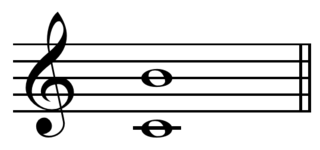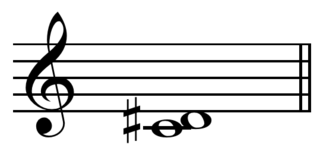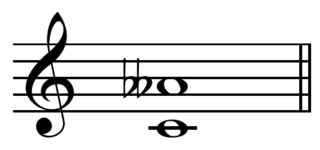In music theory, an interval is a difference in pitch between two sounds. An interval may be described as horizontal, linear, or melodic if it refers to successively sounding tones, such as two adjacent pitches in a melody, and vertical or harmonic if it pertains to simultaneously sounding tones, such as in a chord.
In music theory, the tritone is defined as a musical interval spanning three adjacent whole tones. For instance, the interval from F up to the B above it is a tritone as it can be decomposed into the three adjacent whole tones F–G, G–A, and A–B.

In music theory, a perfect fifth is the musical interval corresponding to a pair of pitches with a frequency ratio of 3:2, or very nearly so.

In music theory, limits or harmonic limits are a way of characterizing the harmony found in a piece or genre of music, or the harmonies that can be made using a particular scale. The term limit was introduced by Harry Partch, who used it to give an upper bound on the complexity of harmony; hence the name.

In Western music theory, a major second is a second spanning two semitones. A second is a musical interval encompassing two adjacent staff positions. For example, the interval from C to D is a major second, as the note D lies two semitones above C, and the two notes are notated on adjacent staff positions. Diminished, minor and augmented seconds are notated on adjacent staff positions as well, but consist of a different number of semitones.
The intervals from the tonic (keynote) in an upward direction to the second, to the third, to the sixth, and to the seventh scale degrees of a major scale are called major.

A semitone, also called a minor second, half step, or a half tone, is the smallest musical interval commonly used in Western tonal music, and it is considered the most dissonant when sounded harmonically. It is defined as the interval between two adjacent notes in a 12-tone scale, visually seen on a keyboard as the distance between two keys that are adjacent to each other. For example, C is adjacent to C♯; the interval between them is a semitone.

In classical music, a third is a musical interval encompassing three staff positions, and the major third is a third spanning four half steps or two whole steps. Along with the minor third, the major third is one of two commonly occurring thirds. It is described as major because it is the larger interval of the two: The major third spans four semitones, whereas the minor third only spans three. For example, the interval from C to E is a major third, as the note E lies four semitones above C, and there are three staff positions from C to E.
The intervals from the tonic (keynote) in an upward direction to the second, to the third, to the sixth, and to the seventh scale degrees of a major scale are called "major".

In music theory, a minor third is a musical interval that encompasses three half steps, or semitones. Staff notation represents the minor third as encompassing three staff positions. The minor third is one of two commonly occurring thirds. It is called minor because it is the smaller of the two: the major third spans an additional semitone. For example, the interval from A to C is a minor third, as the note C lies three semitones above A. Coincidentally, there are three staff positions from A to C. Diminished and augmented thirds span the same number of staff positions, but consist of a different number of semitones. The minor third is a skip melodically.

In music from Western culture, a seventh is a musical interval encompassing seven staff positions, and the major seventh is one of two commonly occurring sevenths. It is qualified as major because it is the larger of the two. The major seventh spans eleven semitones, its smaller counterpart being the minor seventh, spanning ten semitones. For example, the interval from C to B is a major seventh, as the note B lies eleven semitones above C, and there are seven staff positions from C to B. Diminished and augmented sevenths span the same number of staff positions, but consist of a different number of semitones.
The intervals from the tonic (keynote) in an upward direction to the second, to the third, to the sixth, and to the seventh scale degrees (of a major scale are called major.

In music from Western culture, a sixth is a musical interval encompassing six note letter names or staff positions, and the major sixth is one of two commonly occurring sixths. It is qualified as major because it is the larger of the two. The major sixth spans nine semitones. Its smaller counterpart, the minor sixth, spans eight semitones. For example, the interval from C up to the nearest A is a major sixth. It is a sixth because it encompasses six note letter names and six staff positions. It is a major sixth, not a minor sixth, because the note A lies nine semitones above C. Diminished and augmented sixths span the same number of note letter names and staff positions, but consist of a different number of semitones.
The intervals from the tonic (keynote) in an upward direction to the second, to the third, to the sixth, and to the seventh scale degrees (of a major scale are called major.

In Western classical music, a minor sixth is a musical interval encompassing six staff positions, and is one of two commonly occurring sixths. It is qualified as minor because it is the smaller of the two: the minor sixth spans eight semitones, the major sixth nine. For example, the interval from A to F is a minor sixth, as the note F lies eight semitones above A, and there are six staff positions from A to F. Diminished and augmented sixths span the same number of staff positions, but consist of a different number of semitones.

In Western classical music, an augmented fifth is an interval produced by widening a perfect fifth by a chromatic semitone. For instance, the interval from C to G is a perfect fifth, seven semitones wide, and both the intervals from C♭ to G, and from C to G♯ are augmented fifths, spanning eight semitones. Being augmented, it is considered a dissonant interval.

In music, an augmented sixth is an interval produced by widening a major sixth by a chromatic semitone. For instance, the interval from C to A is a major sixth, nine semitones wide, and both the intervals from C♭ to A, and from C to A♯ are augmented sixths, spanning ten semitones. Being augmented, it is considered a dissonant interval.

In music theory, a comma is a very small interval, the difference resulting from tuning one note two different ways. Traditionally, there are two most common comma; the syntonic comma, "the difference between a just major 3rd and four just perfect 5ths less two octaves", and the Pythagorean comma, "the difference between twelve 5ths and seven octaves". The word comma used without qualification refers to the syntonic comma, which can be defined, for instance, as the difference between an F♯ tuned using the D-based Pythagorean tuning system, and another F♯ tuned using the D-based quarter-comma meantone tuning system. Intervals separated by the ratio 81:80 are considered the same note because the 12-note Western chromatic scale does not distinguish Pythagorean intervals from 5-limit intervals in its notation. Other intervals are considered commas because of the enharmonic equivalences of a tuning system. For example, in 53TET, B♭ and A♯ are both approximated by the same interval although they are a septimal kleisma apart.

In classical music from Western culture, an augmented second is an interval that, in 12-tone equal temperament, is sonically equivalent to a minor third, spanning three semitones, and is created by widening a major second by a chromatic semitone. For instance, the interval from C to D is a major second, two semitones wide, and the interval from C to D♯ is an augmented second, spanning three semitones.

In classical music from Western culture, a diminished seventh is an interval produced by narrowing a minor seventh by a chromatic semitone, and its inversion is the augmented second. For instance, the interval from A to G is a minor seventh, ten semitones wide, and both the intervals from A♯ to G, and from A to G♭ are diminished sevenths, spanning nine semitones. Being diminished, it is considered a dissonant interval.

In classical music from Western culture, a diminished fourth is an interval produced by narrowing a perfect fourth by a chromatic semitone. For example, the interval from C to F is a perfect fourth, five semitones wide, and both the intervals from C♯ to F, and from C to F♭ are diminished fourths, spanning four semitones. Being diminished, it is considered a dissonant interval.

The harmonic seventh interval, also known as the septimal minor seventh, or subminor seventh, is one with an exact 7:4 ratio (about 969 cents). This is somewhat narrower than and is, "particularly sweet", "sweeter in quality" than an "ordinary" just minor seventh, which has an intonation ratio of 9:5 (about 1018 cents).

In classical music from Western culture, a diminished sixth is an interval produced by narrowing a minor sixth by a chromatic semitone. For example, the interval from A to F is a minor sixth, eight semitones wide, and both the intervals from A♯ to F, and from A to F♭ are diminished sixths, spanning seven semitones. Being diminished, it is considered a dissonant interval, despite being equivalent to an interval known for its consonance.

















